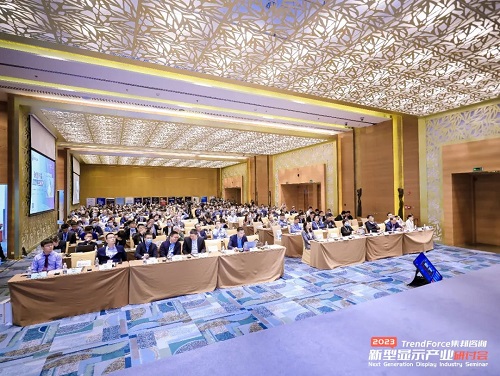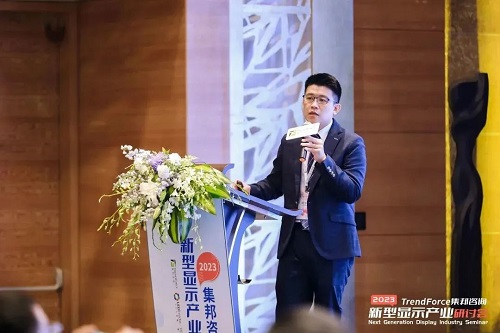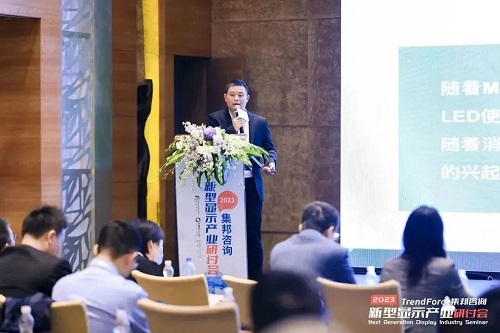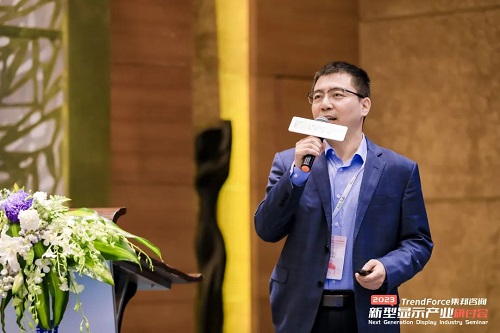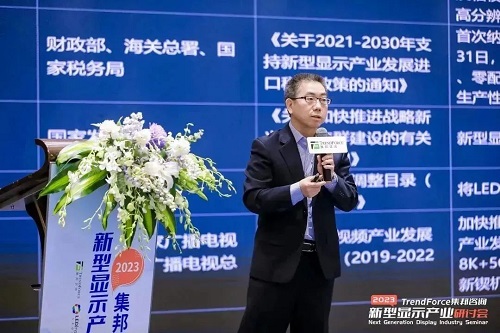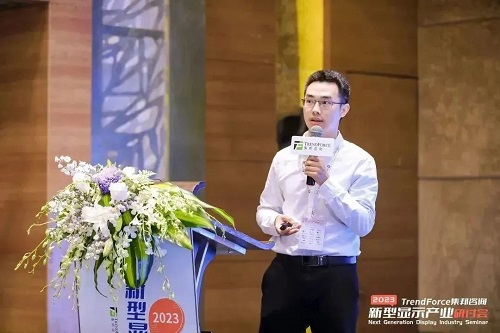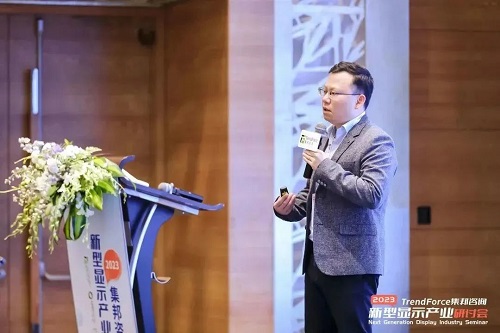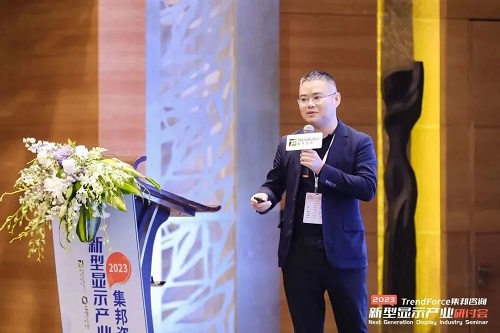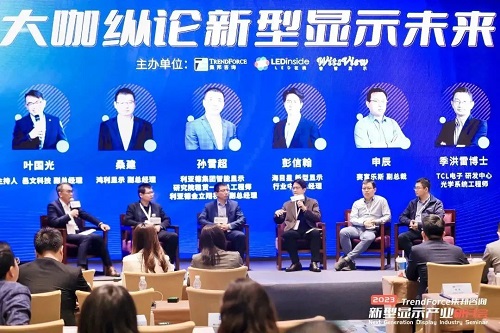Feng Yang, general manager of the xR department at Unilumin
Trend Analysis of MiP Packages for LED Display Market
Presented by Chun-wei Yan from Kinglight
LED displays are advancing towards high definition designs with smaller pixel pitch year by year. The market demand for fine-pitch and ultra-fine pitch displays continues to increase, showing a rapid growth trend.
In terms of packaging technologies, there are various options available such as IMD, MiP, COB and COG. Kinglight developed the MiP technology in 2021 with products such as the MC1010, MC0606 and MC0404, with the most notable feature being their low cost. Reportedly, the price of an MiP lamp bead produced by the manufacturer is equivalent to the cost of a single RGB chip set.
In terms of packaging technologies, there are various options available such as IMD, MiP, COB and COG. Kinglight developed the MiP technology in 2021 with products such as the MC1010, MC0606 and MC0404, with the most notable feature being their low cost. Reportedly, the price of an MiP lamp bead produced by the manufacturer is equivalent to the cost of a single RGB chip set.
Additionally, Kinglight’s MiP products have significant cost advantages in chips, downstream substrates, fixed asset investments and production expenditure. They also enable flexible manufacturing and independent control at the downstream sector, demonstrating strong market competitiveness.
Chun-wei Yan, R&D director at Kinglight
Mass Production of μLED Epi-Wafers: Challenges and Solutions
Presented by Zi-wen Fang from AIXTRON
Micro LED offers significant display advantages such as higher pixel density, longer product lifetime, strong brightness, shorter turn-on/turn-off time and wider color spectrum. Specifically, its low energy consumption makes Micro LED a suitable technology for small displays in future generations as they mostly come with a very limited battery space.
Mass production of Micro LEDs requires specified transfer process, during which millions of micrometer-sized LEDs (matrix) are picked and transferred, where any defect can lead to matrix dysfunction.
AIXTRON’s MOCVD systems AIX G5+ C and G10-AsP were developed based on its proprietary Planetary Reactor technology, equipping the manufacturer for next-gen Micro LED displays with high definition.
To avoid the problem, an epitaxy approach with nearly zero error must be implemented to minimize defects and maximize uniformity, thereby achieving production of Micro LEDs with high yield and desirable economic viability.
The AIX G5+C and fully automated G10-AsP measuring 200mm are the largest batch Micro LED reactors that are currently available in the market, both featuring in-situ cleaning and a C2C (cassette-to-cassette) wafer handler. For the first time, the front-end of the G10-AsP can be combined with SMIF (standard mechanical interface) pods to reduce indoor exposure for epi-wafers. The default in-situ cleaning function allows users to reset chamber conditions according to their need—whether it is the most demanding requirements after each process run or the highest throughout after a production cycle. As the Planetary Reactor technology successfully integrates the concept of multi-wafer batch reactors with that of single-wafer rotation, the platform guarantees optimal wafer uniformity.
Zi-wen Fang, vice president at AIXTRON
Advanced Roadmap for Next-Gen Displays: Competitive Advantages of Mini LED in Small and Mid-Sized Display Applications
Presented by Jia-xian Zhang from Refond Optoelectronics
The market potential for small and medium-sized displays is enormous, where backlit components need to be thin while also featuring high brightness, high contrast and high energy efficiency. Among the existing display technologies, Mini LED backlight technology is best poised to meet these requirements.
In order to produce thin and high-performing Mini LED backlight modules, numerous problems need to be addressed, including those related to PCB substrate materials, encapsulation processes, chip arrangement and dimming, packaging structures, and optical films.
With extensive experience in the Mini LED business, Refond has seen its technology, production capacity and yield of Mini LED products achieve the mass production level. Through core technologies such as flip-chip bonding, COB packaging, mold injection and thermal curing, and proprietary patents of uniform structure designs, Refond has developed high-quality ultra-thin (≤2mm) Mini LED backlight modules with good consistency, high luminous efficacy and a low cost. These breakthroughs have solved the challenges in Mini LED backlight applications and opened up greater possibilities for the technology in various applications.
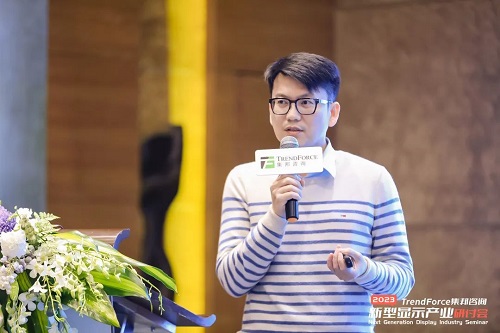
Jia-xian Zhang, R&D director and vice president at Refond Optoelectronics
A New Stage for Glass-based Mini LEDs
Presented by Hai-wei Sun from BOE Jingxin Technology
As the display market continues to evolve with technological advancements, users start to demand more for display performance. In the future, display products have to be able to deliver more information, higher image quality, longer viewing time with convenient and highly integrated functions.
Glass-based MLED will be a display technology better suited for the future development of the industry.
In terms of display performance, glass-based MLED can achieve smaller pixel pitch and boasts superior
molding uniformity , optical performance and high flatness. As a result, glass-based MLED products offer more refined image quality compared to PCB products.
Furthermore, the use of glass substrates and AM (active matrix) driving technology allows the glass-based MLED displays to achieve full grayscale without flickering, making them more eye-friendly. They also show better performance in heat dissipation and consume 20% less power compared to their PM (passive matrix) counterparts.
Their high resolution, high brightness, flicker-free, and high transparency enable glass-based MLEDs to fit various applications including xR filming, transparent displays, automotive displays, consumer electronics and more.
Jingxin has announced the mass produced P0.9 COG MLED display and is now developing products with smaller pixel pitch. In the Micro LED segment, the chipmaker is attempting to integrate its high-precision semiconductor processes with massive transfer technologies and LED chip-making strategies, aiming to develop relevant products.
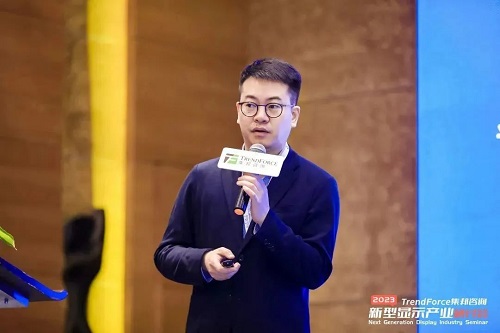
Hai-wei Sun, director of MLED business development center at BOE
COB Display Control and High Definition Solutions
Presented by Dr. Guo-jing He from NovaStar
The control system is one of the most technologically advanced components of an LED display, consisting of a controller and a receiving card. The controller works by receiving signals and completing data processing tasks—such as decoding, data segmentation, and format conversion—before outputting them to the receiving card. Once the receiving card obtains the signals, it controls the brightness, color, and on/off status of each LED in an individual cabinet, allowing the LED array to display images.
Dr. He indicated that advances in technologies such as NovaStar’s 5G+8K as well as Mini/Micro LED displays are driving the LED display industry towards ultra-high-definition smart display and miniaturization, to which control systems need to be adapted accordingly.
NovaStar’s latest solution enables the controller to achieve single-port 8K resolution with a smaller form factor and lower power consumption. Moreover, it features an Ethernet interface, Type-C interface and 5G wireless technology, catering to various data transmission needs.
The receiving card also boasts a smaller size and lower power consumption along with increased load capacity and various new algorithms such as Xbit+, fine grayscale, and ABL, addressing issues related to brightness uniformity and color accuracy in COB and other fine-pitch products. The innovation in NovaStar's control system enables true-to-life display achieved through Mini/Micro LEDs, delivering exceptional image quality to users.
Dr. Guo-jing He from NovaStar
Development Trends in the Mini LED COB Industry
Presented by Zhou-cheng Xiong from MTC Display
MTC Group has vertically integrated its LED production, where MTC Display is positioned as a supplier at the downstream. MTC Display created six major production lines for COB products, namely the Real Pixel, direct-view LED TV, Glasses-Free 3D, Creative Display, Meta Visual and Education Display lines.
Specifically, the manufacturer has massed produced P0.78, P0.93, P1.25, P1.56 and P1.87 Real Pixel products, while the Meta Visual line comprises products engineered with subpixel rendering that can create visual experiences with higher resolution within the same space. The Education and Glasses-Free 3D are two emerging segments that the company has been investing in. The direct-view TV business signifies the display maker’s focus on the consumer market.
Adopting the flip-chip COB technology, MTC Display provides products with high
molding uniformity, high color consistency, wide DCI color gamut and integrated three-in-one power system board; these anti-humidity, anti-collision, anti-static and washable products come with various advantages such as matte paint finish and 4H-grade hardness, which are engineered with more than 100 patents.
Concerning production capacity, MTC Display had 100 production lines of COB display modules as of 2H22. In November 2022, the number jumped to 600 after its Nanchang plant began operating, and was further boosted to 1,600 in 1Q23. The manufacturer plans to have more than 5,000 such production lines in the coming years.
Zhou-cheng Xiong, vice president at MTC Display
Micro LED High-Precision Mass Transfer and High-Speed Mass Inspection
Compared to display technologies such as LCD and OLED, Micro LED exhibits outstanding performance in terms of color accuracy, contrast ratio, response time, viewing angle, resolution, brightness and lifespan. However, cost remains a major challenge in its development. Under such circumstances, accelerating mass transfer and improving mass inspection have become crucial issues for the Micro LED industry to reduce manufacturing costs.
Currently, there are mainly two types of Micro LED color mixing technologies. The RGB mass transfer technology allows LEDs in three different colors to be transferred simultaneously. On the other hand, the single-color blue chip transfer + quantum dot technology works by transferring blue chips in batches first before changing some of their colors using the quantum dot method.
Constringing on the optimization of mass transfer and mass inspection processes, StarSky Technology has developed various Micro LED machines including an In/Au chip bonder (flip-chip bonding), all-in-one wafer alignment/bonding equipment with high precision (μm-grade wafer bonding), mass inspector for chip offset positions (chip offset detection), optical nanoscale equipment (3D topography measurement) and nanoimprint lithography machine (precise chip bonding). The products will help reduce enhance the yield of Micro LEDs at a lower cost and accelerate the cutting-edge technology’s industrialization.

Yong-hui Chen from StarSky Technology
Breakthroughs in Mini LED driver ICs
Presented by Xiang-nan Song from Sunmoon Microelectronics
In recent years, both Mini LED direct-view displays and backlight technologies have been rapidly advancing, with applications expanding to diverse fields such as office and education, commercial retail, smart display, and end-market entertainment applications.
As Mini LED continues to rapidly grow, various problems related to its applications have appeared due to different requirements in various market segments, leading to stricter requirements for display driver IC technologies. In response to the display problems caused by Mini LED, Sunmoon provides comprehensive driver IC solutions.
To solve problems faced by direct-view Mini LED displays (e.g., parasitic coupling, temperature and power consumption, spatial layout, low-grayscale refresh rate and display consistency), Sunmoon incorporated its driver IC solutions with patented common-cathode integrated driving, smart energy saving, SM_PWM smart display processing, and LED polarity short-circuit detection and processing technologies, thereby overcoming difficulties in applying Mini LED direct-view displays.
As for problems facing Mini LED backlights, such as high costs, undesirable dimming as well as inconsistent display uniformity, brightness and power consumption, Sunmoon offers the PM driver SM6610 featuring integrated line scanning decoding, compatibility with high-voltage power supply and self-adjusting algorithms, as well as the AM driver SM6212 featuring 12 channels, compatibility with single-sided PCB wiring, anomaly detection and signal retransmission, and information feedback and interaction, meeting the requirements of various Mini LED backlight applications.
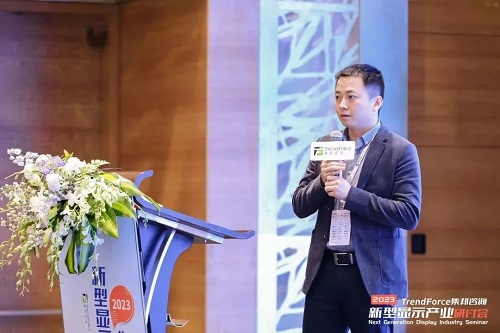
Xiang-nan Song, market director of LED display driver technologies at Sunmoon Microelectronics
Global LED Display Market: Opportunities and Challenges for 2023
Presented by Allen Yu from TrendForce
According to TrendForce’s latest data, the overseas market demand recovered considerably despite a slump in the demand for LED displays in China throughout 2022, while LED virtual production, all-in-one machines and other new applications continued to grow.
The size of the global LED display market still reached USD 7 billion in 2022. Entering 2023, market demand did not return as expected as per the performance in 1Q23. Nonetheless, the market will likely bounce back in the second half of the year with rising demand for both distribution-based and project-based displays. Conversely, the overseas demand will remain mostly the same as it was in 2022. Driven by the demand for new applications in virtual production studios, all-in-one machines and cinemas, the LED display market is estimated to see a 13% growth rate in 2023. In the long run, TrendForce optimistically predicts the market will be valued at USD 13 billion in 2026 thanks to the rise of fine-pitch and Mini LED displays.
From the technological perspective, when manufacturers start targeting at fine-pitch LED displays with a ≥P1.2 pixel pitch after COB, MiP and relevant technologies mature, other LED approaches such as SMD/N in 1 will be affected somewhat. Considering such technological competition, uncertainty will remain in the industry chain with revolution of industrial specialization being possible.
Allen Yu, research manager at TrendForce
Panel Discussion
Later, a panel discussion was hosted by AMTE vice president Guo-guang Ye.
Several guest speakers were invited during this session, including Jian Sang (VP at Honglitronic), Xue-chao Sun (chief engineer of First Smart Display Laboratory at Leyard and vice president at Glux), Xin-hang Peng (general manager of Hymson’s Next-Gen Display Center), Chen Shen (VP at Saphlux) and Dr. Hong-lei Ji (optical system engineer of TCL Electronics’ R&D Center).
During the session, guest speakers shared their insights into trending topics within the display industry, such as the impact of the Chinese and global economy in 2023 on the display industry, market outlook of COB displays with a P1.0 or higher pixel pitch, development of Mini LED TVs and Micro LED commercialization. Together, they devised corresponding strategies for the display industry and envisioned the future of next-gen displays.
Guest speakers talk during the panel discussion
Publication dates: May 31, 2022 and November 30, 2022
Format: PDF
Languages: Traditional Chinese/English
Number of pages: 130–150 in total (subject to change)
Publication dates: April 30, 2022 and October 31, 2022
Languages: Traditional Chinese/English
Format: PDF
Number of pages: 120–130 for the two publications in total
Publication date: September 28, 2022
Languages: Traditional Chinese/English
Format: PDF
Number of pages: 222
If you would like to know more details , please contact:





 CN
TW
EN
CN
TW
EN

